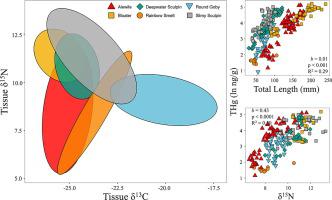Journal of Great Lakes Research ( IF 2.2 ) Pub Date : 2021-09-15 , DOI: 10.1016/j.jglr.2021.08.019 Whitney M. Conard 1 , Brandon S. Gerig 2 , Lea M. Lovin 1 , David B. Bunnell 3 , Gary A. Lamberti 1

|
Developing an understanding of factors that influence the accumulation and magnification of heavy metals in fish of the Laurentian Great Lakes is central to managing ecosystem and human health. We measured muscle tissue concentrations of heavy metals in Lake Michigan prey fish that vary in habitat use, diet, and trophic position, including alewife, bloater, deepwater sculpin, round goby, rainbow smelt, and slimy sculpin. For each individual, we measured tissue concentrations of four metals (chromium [Cr], copper [Cu], manganese [Mn], and total mercury [THg]), stable isotope ratios for trophic position (δ15N and δ13C), and individual fish attributes (length, mass). Total mercury concentration was positively related to total length and δ15N. Of all species, round goby had among the greatest increases in mercury per unit growth and was most isotopically distinct from other species. Profundal species (bloater, deepwater sculpin, slimy sculpin) had similar high THg tissue concentrations, possibly due to slower growth due to cold temperatures, whereas other species (alewife, round goby, rainbow smelt) showed more variation in THg. In contrast, other metals (Cr, Cu, Mn) had either a negative or no relationship to total length and δ15N, suggesting no bioaccumulation or biomagnification. Potential incorporation of mercury by sportfish may thus be related to species, age, diet, trophic position, and habitat of prey fish. Our findings serve as a foundation for understanding how heavy metals accumulate in Lake Michigan food webs and highlight the continued need for management of metal input and cycling in Lake Michigan.
中文翻译:

密歇根湖猎鱼的金属积累:个体发育、营养位置和栖息地的影响
了解影响劳伦森五大湖鱼类中重金属积累和放大的因素对于管理生态系统和人类健康至关重要。我们测量了密歇根湖猎物肌肉组织中重金属的浓度,这些鱼类在栖息地使用、饮食和营养位置方面各不相同,包括 alewife、膨胀鱼、深水杜鱼、圆虾虎鱼、彩虹鱼和粘糊糊的杜鱼。对于每个个体,我们测量了四种金属(铬 [Cr]、铜 [Cu]、锰 [Mn] 和总汞 [THg])的组织浓度、营养位置的稳定同位素比率(δ 15 N 和 δ 13 C) ,以及个别鱼的属性(长度、质量)。总汞浓度与总长度和δ 15呈正相关N. 在所有物种中,圆虾虎鱼每单位生长的汞含量增加最多,并且在同位素上与其他物种的区别最大。深海物种(浮肿、深水杜鹃、黏糊糊的杜鹃)具有类似的高 THg 组织浓度,可能是由于低温导致生长缓慢,而其他物种(金鱼、圆虾虎鱼、彩虹鱼)的 THg 变化更大。相比之下,其他金属(Cr、Cu、Mn)与总长度和 δ 15呈负相关或没有关系N,表明没有生物积累或生物放大作用。因此,游鱼可能掺入的汞可能与猎物的种类、年龄、饮食、营养位置和栖息地有关。我们的研究结果为了解重金属如何在密歇根湖食物网中积累奠定了基础,并强调了对密歇根湖金属输入和循环管理的持续需求。


























 京公网安备 11010802027423号
京公网安备 11010802027423号